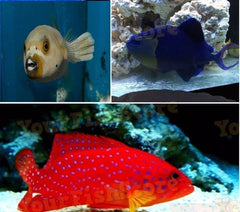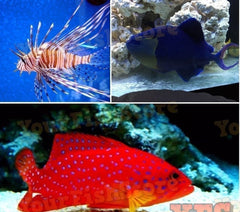Blue Face Angel Fish - Med 3" - 4" Saltwater Yourfishstore
Ebay
$ 253.54

BLUE FACE ANGEL FISH - MED 3" - 4" SALTWATER YOURFISHSTORE - FREE SHIPPING
Minimum Tank Size: 200 gallons
Care Level: Moderate
Temperament: Semi-aggressive
Reef Compatible: With Caution
Water Conditions: 72-78° F, dKH 8-12, pH 8.1-8.4, sg 1.020-1.025
Max. Size: 1' 3"
Color Form: Black, Blue, Yellow
Diet: Omnivore
Description
The Blueface Angelfish is considered to be a moderately hardy specimen but should be attempted by aquarists with a moderate amount of experience. Probably one of the most striking and colorful of the angelfish, the Blueface Angelfish will not tolerate bullying and likes to have a lot of swimming space and places to hide. It does not tend to be aggressive as many other Angelfish but may harass close relatives. It is often noted that the Juvenile or younger blueface angels usually adapt more readily to captivity than adults.
Most large angelfish are known for nipping at large-polyped stony corals and some soft corals (e.g. Xenia) as well as tridacnid clam mantles. It is not considered reef safe though some specimens have been reported to live peacefully without harassing small-polyped stony corals and soft corals of a more 'noxious' nature
Diet
Feed the Blueface Angelfish a varied diet of meaty marine foods such as shrimp, mysis shrimp, clam, scallop, squid, and silversides. Be sure to offer marine algae such as Spirulina and dried sheets of nori. Feeding nori is best accomplished by tearing off a strip and inserting it into a lettuce clip or between your cleaning magnets. To encourage good coloration, it is recommended to feed commercially prepared Angelfish formula that contains marine sponge material. In order to maintain the proper amount of body fat for this fish, it will likely need to be fed 2 - 3 times daily.
Referred to variously as the Blueface, Yellowface, or Yellowmask Angelfish, the adult and juvenile Blueface Angelfish differ markedly in coloration. As a juvenile, the body is covered with alternating vertical stripes of black, white, and sapphire blue. Upon growing to approximately five inches, the juvenile begins to morph into its adult coloration of pale yellow with bluish scales and a bright-yellow pectoral fin. It has a mottled-blue face with yellow mask that extends from eye to eye but not much beyond each eye. There is also an eyespot at the caudal end of the dorsal fin.
QUESTIONS & ANSWERS
Have a Question?
Be the first to ask a question about this.














